Clean Air Markets
Impacts of Proposed Interstate Air Quality Rule
Highlights
- The proposed Interstate Air Quality Rule (IAQR) would substantially reduce emissions of SO2 and NOx in the eastern United States.
- When fully implemented, NOx emissions would be reduced 70 percent below current levels and SO2 would be reduced 65 percent.
- By 2015, the rule would yield approximately $84 billion in annual benefits, including:
- $82.4 billion in annual health benefits from reductions in fine particle and ozone concentrations; and
- $1.4 billion in annual visibility improvements in Southeastern
national parks and forests.
- In 2015, EPA projects 28 additional counties would attain the fine particle health standard and 8 additional counties would attain the 8-hour ozone standard.
- The eastern U.S. would also receive environmental benefits, including reductions in acid deposition that would benefit forests and streams, and reductions in nitrogen deposition that would benefit coastal waters.
- The benefits of the proposed rule far outweigh the costs.
- More than $22 in benefits would be realized for every dollar of costs for the proposed Interstate Air Quality Rule.
- Annual costs by 2015 are projected to be approximately $3.7 billion.
States Covered by the Proposed Rule
- The proposed rule would cover 29 states and the District of Columbia.
Proposed IAQR: Affected Region

- In the proposed rule, EPA found that 28 eastern states and the District of Columbia contribute to unhealthy levels of fine particles. EPA found 25 eastern states plus the District of Columbia contribute to unhealthy levels of 8-hour ozone.
- EPA is also soliciting comments on an alternative analysis for fine particles, which would add two states covered by the proposed rule - North Dakota and Oklahoma.
8-hour ozone: Summertime NOx reduction requirements for 25 states
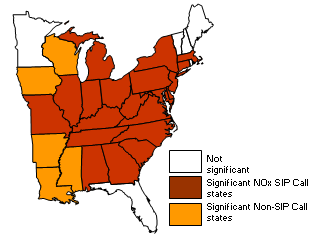
PM2.5: Annual SO2 and NOx reduction requirements for 25 states

Projected Emission Reductions
- Each affected state would be required to revise its State Implementation Plan to include control measures to meet specific statewide emission reduction requirements.
- To achieve the required reductions in the most cost effective way, the proposal recommends that states regulate power plants under a cap and trade program. Under a cap and trade approach, emissions would be permanently capped and could not increase.
- States would have flexibility on how to achieve the reductions, including which sources to control, and whether to join the trading program.
- The proposed rule would set emission caps for SO2 and NOx in two phases:
Emission Caps (million tons)
| 2010 | 2015 | |
|---|---|---|
| SO2 | 3.9 | 2.7 |
| NOx | 1.6 | 1.3 |
- The proposed cap and trade program would reduce SO2 emissions by 3.6 million tons in 2010 (approximately 40 percent below current levels) and by another 2 million tons per year when the rules are fully implemented (approximately 70 percent below current levels).
- NOx emissions would be cut by 1.5 million tons in 2010, and by 1.8 million tons annually in 2015 (about 65 percent below current levels).
- Projected controls on power plants to meet SO2 and NOx requirements are also expected to result in some reductions in mercury emissions.
Projected Annual SO2 Emissions for Electric Generating Units (EGUs) Under the IAQR

Projected Annual NOx Emissions for EGUs Under the IAQR

Areas Projected to Meet 8-hour Ozone and Fine Particle Air Quality Standards
- The proposed rule would help states meet the National Ambient Air
Quality Standards (NAAQS). By 2015, based on air quality modeling, the
proposed rule would be expected to:
- Bring 28 additional eastern counties into attainment with the fine particle standard.
- Bring 8 additional counties into attainment with the 8-hour ozone standard.
Areas Projected to Remain Out of Attainment
- The NOx SIP Call will bring many Eastern counties into attainment with the 8-hour ozone standard. The IAQR proposal will bring 8 additional counties into attainment with the ozone standard and 28 additional eastern counties into attainment with the fine particle standard as compared to the Base Case.
- With implementation of the proposed Interstate Air Quality Rule, the counties remaining out of attainment are expected to move closer to attainment, and provide health benefits to the people who live there.
- In 2015, 13 counties would remain nonattainment for fine particles and 26 would remain nonattainment for 8-hour ozone.
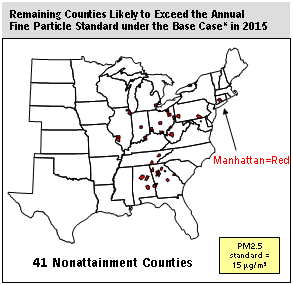

Notes: Based on 1999-2001 and 2000-2002 data
of counties with monitors that have three years of complete data. The
IAQR is not expected to bring additional counties into attainment for
2015 in the West. Therefore, the western region is not presented here.
"Base case" assumes implementation of existing Clean Air Act programs
and proposed nonroad diesel rule.
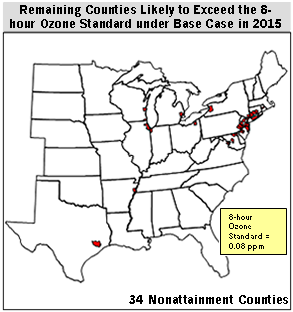
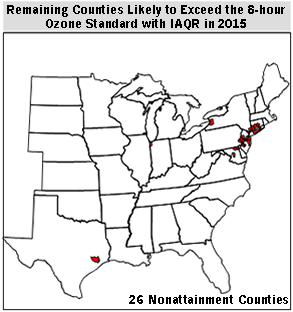
Health and Environmental Benefits
Improving Human Health
- Once final, the proposed rule would begin reducing fine particle and
ozone pollution immediately, resulting in an estimated $82.4 billion
in annual public health benefits in 2015. Each year, by 2015, Americans
would experience approximately:
- 13,000 fewer premature deaths;
- 6,900 fewer cases of chronic bronchitis;
- 18,000 fewer non-fatal heart attacks;
- 240,000 fewer asthma attacks in children 6 to 18;
- 8.5 million fewer days when people have to restrict their activities because of reduced lung function and other respiratory symptoms
- 22,500 fewer hospitalizations and emergency room visits; and
- 1.7 million fewer absences from work and school.
Improving Visibility
- The proposed Interstate Air Quality Rule would improve visibility in many of our treasured natural areas.
- In a large portion of the Southeast, visibility would be improved by over 1 deciview from current levels (a 1 deciview improvement is a perceptible change to the human eye).
- By 2015, annual visibility benefits would reach an estimated $1.4 billion for improvements in southeastern Class I areas (national parks, forests and wilderness areas).
Reducing Acid Deposition
- In the East, sulfur deposition, a primary cause of acid rain, will decrease up to 20 percent in the year 2010, while some portions of Pennsylvania, Virginia, Maryland, and West Virginia will see reductions of up to 45 percent. In 2015, the Southeast will experience additional reductions.
- Nitrogen deposition, another significant contributor to acid rain as well as a cause of damage in nitrogen-sensitive forests and coastal waters, would decrease up to 15 percent in many areas of the eastern U.S. in the year 2010 with even larger reductions in 2015.
- Significant regional reductions in sulfur and nitrogen deposition are projected to benefit lakes and streams in the eastern U.S. For example, in the Northeast Region, chronic acidity would be dramatically reduced by 2030 (only 1 percent of lakes remain acidic). Chronic acidity in the Adirondack Mountains would be virtually eliminated by 2030.
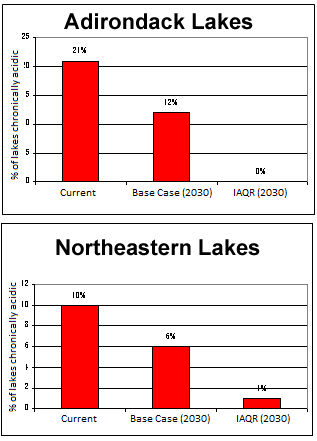
Economic Impacts
- Using a variety of models and other analytical tools, EPA evaluated the compliance costs and related impacts of the emissions cap on affected sources.
- The annual compliance costs are projected to be approximately $2.9 billion in 2010 and $3.7 billion in 2015.
- The proposed rule is not expected to result in any significant changes in retail electricity prices.
Regional Retail Electricity Prices |
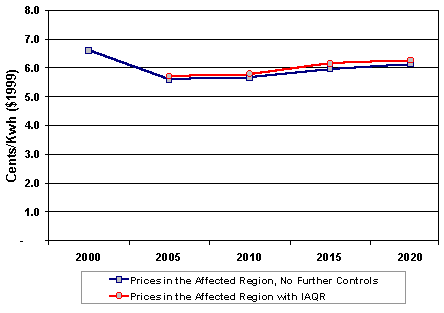 |
« Return to Regulatory Actions
